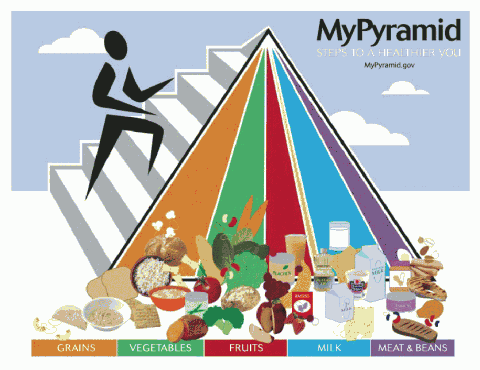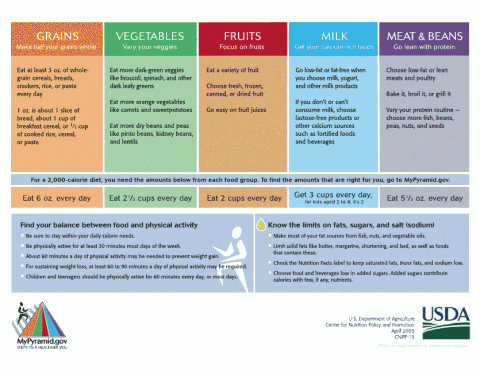 When I first saw the new food pyramid, I was flummoxed. What made whoever designed this pyramid of descending rays of color think that this was an easily understood chart!
When I first saw the new food pyramid, I was flummoxed. What made whoever designed this pyramid of descending rays of color think that this was an easily understood chart!
The old food pyramid had different sections with individual foods in each that equaled the number of foods in that category you should eat each day. For instance, if you needed five vegetables, it showed five different colorful vegetables in that area of the chart.
The new chart has foods at the bottom of each colorful ray. What does this mean?
First, let me assure you that this came about as a result of a law passed by Congress that dictated that the amount of foods required by Americans on a daily basis be reviewed every five years. With the growing rate of obesity in this country, it appeared that diet was a major issue for many people. The Department of Education, as I understand it (and I suspect in cooperation with the U. S. Department of Agriculture), came up with the current requirements and this lovely food pyramid.
The new daily requirements for children are six ounce equivalents of grains, 2½ cups of vegetables, 1½ cups of fruits, 3 cups of milk, and 5 ounce equivalents of meat and beans.
Grain
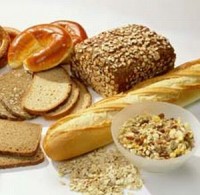 In the grain category, at least half of what you eat should be whole grains each day. (Don’t even consider eating white sandwich bread!) Translated into foods, this means a one ounce equivalent is about one slice of bread or one cup of dry cereal or ½ cup of cooked rice, pasta or cereal (oatmeal, etc.) each day. So if you had a couple of pieces of toast at breakfast, ½ cup of spaghetti and a slice of bread for lunch, and ½ cup of rice and another slice of bread for dinner, you’d be on track.
In the grain category, at least half of what you eat should be whole grains each day. (Don’t even consider eating white sandwich bread!) Translated into foods, this means a one ounce equivalent is about one slice of bread or one cup of dry cereal or ½ cup of cooked rice, pasta or cereal (oatmeal, etc.) each day. So if you had a couple of pieces of toast at breakfast, ½ cup of spaghetti and a slice of bread for lunch, and ½ cup of rice and another slice of bread for dinner, you’d be on track.
Vegetables
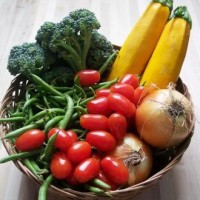 Vegetables should contain over a day’s time a choice of dark green, orange, starchy, dry beans or peas to equal 2½ cups. Since few people eat vegetables at breakfast, this means you should have at least a cup at lunch and 1½ cup at dinner, or vice versa. Some one cup examples of vegetables are one large bell pepper, one medium potato, two large stalks of celery, 12 baby carrots, one large sweet potato, one large ear of corn, or 10 broccoli florets.
Vegetables should contain over a day’s time a choice of dark green, orange, starchy, dry beans or peas to equal 2½ cups. Since few people eat vegetables at breakfast, this means you should have at least a cup at lunch and 1½ cup at dinner, or vice versa. Some one cup examples of vegetables are one large bell pepper, one medium potato, two large stalks of celery, 12 baby carrots, one large sweet potato, one large ear of corn, or 10 broccoli florets.
Fruits
 Fruits can be more whole fruit, if possible, but can include ½ cup of fruit juice, ¼ cup of dried fruit, or ½ cup fresh, frozen, or canned fruit. Here are some examples of one cup of fruit: one small apple, one large banana, one large orange, one medium grapefruit, one medium pear, one small wedge of watermelon, eight large strawberries, two large or three medium plums, 32 grapes, or two small boxes of raisins (¼ ounce boxes).
Fruits can be more whole fruit, if possible, but can include ½ cup of fruit juice, ¼ cup of dried fruit, or ½ cup fresh, frozen, or canned fruit. Here are some examples of one cup of fruit: one small apple, one large banana, one large orange, one medium grapefruit, one medium pear, one small wedge of watermelon, eight large strawberries, two large or three medium plums, 32 grapes, or two small boxes of raisins (¼ ounce boxes).
Milk
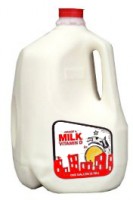 Substitutions for a cup of milk are one cup of yogurt or 1½ ounces of cheese.
Substitutions for a cup of milk are one cup of yogurt or 1½ ounces of cheese.
Meat & Beans
 Your five ounce equivalents of meat and beans are where most of us get into trouble. One ounce of meat is just what it says, so an eight-ounce hamburger has already pushed us over the top. Don’t even contemplate one of the new double cheese burgers with bacon monster meals!
Your five ounce equivalents of meat and beans are where most of us get into trouble. One ounce of meat is just what it says, so an eight-ounce hamburger has already pushed us over the top. Don’t even contemplate one of the new double cheese burgers with bacon monster meals!
One ounce of chicken, turkey or fish is a one ounce serving also. Think about the weight of a whole, or even a half, a fried chicken breast. One egg or one Tablespoon of peanut butter equals an ounce of meat, as does ½ ounce of nuts or ¼ cup of dry beans. Most dieticians advise you to think of a serving of meat as being the size of a deck of cards.
Exercise
O n top of this food pyramid, all of us are advised to have 60 minutes of exercise a day in order to burn up the calories involved in this type of eating.
n top of this food pyramid, all of us are advised to have 60 minutes of exercise a day in order to burn up the calories involved in this type of eating.
For more information
If you want more detailed information, you can just put the word “nutrition” into a search engine on the Web and you’ll be well rewarded at the U.S. Department of Agriculture or mypyramid.gov sites. There’s even a place where you can get a customized plan depending on your age, height, weight and normal daily exercise. (Don’t cheat here! Tell the truth so you can get an accurate chart. No one else can see this so fudging is futile.)
Good health is the first step in the road to happiness. After all, if you don’t feel well, it’s hard to enjoy anything else in life. Forget the new visual pyramid that tells you little about what you’re supposed to be eating. Follow the written guidelines to a healthier you.
Don’t forget. The life you save is definitely your own.

